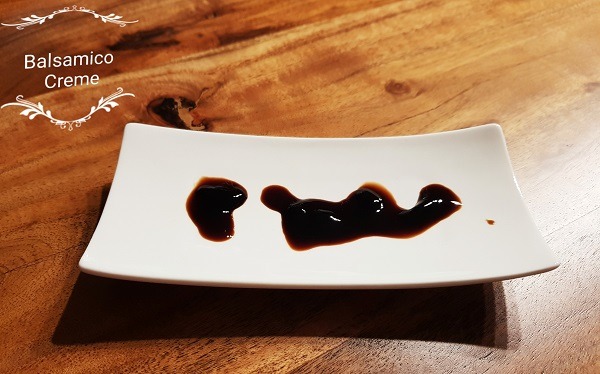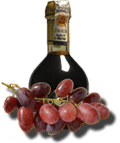For more than the adornment and decoration of a plate or for the visual embellishment when arranging a dish, you should not use a balsamic glaze.
" But it's so delicious and sweet and so completely different from this sour vinegar stuff... ", a reader said to me. He's right - a balsamic glaze has nothing to do with vinegar anymore. Rather something with sugar paste that was colored dark so that it looks like "balsamico" - syrupy, if you are lucky with corn starch and glucose, others would say sugar, so it is an imitation, which a real Aceto Balsamico Tradizionale extra vecchio in color and consistency should be similar and usually available for less than 5 euros. A real balsamic vinegar that has been able to mature long enough (25 years or more) is at least as sweet as a balsamic vinegar, only much more intense and varied than a crema.
Nevertheless - many people like everything that is sweet - unhealthy or not, enriched with sugar, coloring and preservatives, it doesn't matter - the main thing is tasty. A balsamic glaze cannot really be classified as healthy based on its list of ingredients, and unfortunately the glaze is not suitable for weight loss or dieting due to its high sugar content. A classic balsamic glaze does not contain alcohol and can therefore also be classified as halāl ( حلال). The balsamic glaze should also be classified as vegan, as no animal additives are used.
The crema di balsamico or balsamico glaze or balsamico glassa (glaze) - as the Italians call this product, is enjoying increasing popularity and many consumers use the crema to give their salad a dash of exotic, dark sweetness.
The product variants are also becoming more and more extensive. Everything that the food chemistry laboratory allows is processed and rounded off with the name balsamic vinegar. There is now even white , i.e. light (bianco) balsamic glaze, which was modeled on a white industrial vinegar (white balsamic vinegar is not matured in a wooden barrel). Balsamic glazes with raspberry flavor, cherry, orange, pomegranate, currant, fig and strawberry, and even truffle balsamic glazes can be found on the supermarket shelves of Rewe, Real, Edeka, Aldi, Norma and Lidl.
The basis or basic ingredients of a typical balsamic glaze found in stores are:
- Sugar - also under the name:
- Glucose
- Sucrose
- Dextrose
- lactose
- Fructose syrup or fructose-glucose syrup
- Glucose syrup, glucose-fructose syrup or corn syrup
- caramelsirup
- Maltose or malt extract
- Thickener (for the consistency) - e.g. E412 or E415 as well as modified starch (this starch can also be obtained from grain, e.g. wheat, then the balsamic vinegar is no longer gluten-free!)
- Fruit juice, fruit puree or natural or artificial flavors
- Wine vinegar
- Grape must concentrate
- Dye - so it gets dark, otherwise the paste would be much lighter - e.g. E150d
- Preservatives (sulfites - potassium metabisulfite E224) for shelf life
Incidentally, the mixture of concentrated grape must and wine vinegar is called aceto balsamico. The proportion of wine vinegar is the "cheap component" and the concentrated grape must is the "valuable" component. The proportion of grape must concentrate is therefore an indicator of the qualitative value of a balsamic glaze. If the balsamic glaze was made with an "Aceto Balsamico di Modena ", there is a legal minimum requirement for the composition of grape must concentrate and wine vinegar. A " di Modena " must contain at least 20% concentrated grape must. The Acetaia Fini offerseven a balsamic glaze with 90% balsamic vinegar, in which the grape must proportion even predominates (more than 50%).
Consumer tip: If you read " 70% (Aceto Balsamico di Modena: wine vinegar, concentrated grape must) ", you know that it contains more wine vinegar than grape must, as the order of the ingredients determines the proportions. If the grape must comes first and then the wine vinegar, in our experience the product is to be classified as higher quality. Even better if grape must concentrate and Aceto Balsamico di Modena IGP are listed separately. Because then the sweet grape must dominates and the acidity of the balsamic vinegar remains discreetly in the background. However, such a product is rarely found in stores - the Acetaia Terra del Tuono, Mussini and Malpighi produce a balsamic glaze in manageable quantitieswhich, in our opinion, meets these requirements.
Shelf life of a balsamic glaze
Most products contain antioxidants - so-called sulfites - so that they can be kept even after opening. The best way to achieve a long shelf life after opening the bottle is to buy a bottle with a squeezer membrane. These do not allow oxygen to enter the product and if you also store the product in a cool place in the refrigerator, a balsamic crema in such a PET bottle will usually stay open until the best-before date. Due to the sugar and starch in the product, mold will form on an expired balsamic glaze that tastes bitter.
Make your own balsamic glaze
With all the additives in an industrially manufactured balsamic glaze, it is obvious that you can easily make it yourself. In addition to the balsamic vinegar, the main ingredient is of course >>> sugar <<
Preparation time: 10 minutes
Preparation time: 17 minutes

Our recipe for a crema di balsamico, as it is also served in Italy:
Ingredients for 250ml balsamic glaze:
- 250 ml Bio Balsamic Vinegar of Modena
- 250 ml dry red wine, for example a Dornfelder
- 80 g cane sugar or brown sugar
- 2 tbsp organic honey from the region (no liquid honey)
Put the Aceto Balsamico di Modena, the wine and the sugar in a saucepan - preferably one with a non-stick base. After that, bring the liquid to a boil. Then then lower the heat to a minimum and continue cooking until the liquid is reduced by half. Let it cool down now. The crema thickens a little and then you pour the resulting balsamic glaze into a container with a nozzle, with which you can decorate your salads or a plate with tomato-mozzarella. Your own balsamic glaze dressing is ready !
Estimated nutritional values: According to this recipe, 250ml have approx. 400 kcal (kilo calories) of which approx. 80g are carbohydrates.
Tip: You can also replace the red wine with a non-alcoholic liquid - for example cherry juice, orange juice or elderberry juice, depending on your taste. The classic is the red wine - in this combination the glaze is also suitable for roasts and other meat dishes. The process of making your own balsamic glaze is similar to that of reducing balsamic vinegar.
For cooks keen to experiment: A balsamic glaze without sugar could only be produced with sufficient thickening agents such as xanthan gum and sweeteners or stevia gelling sugar - a Thermomix recipe for such a sugar-free balsamic glaze can be found online here.
For questions, suggestions and opinions, just send me an email to: info@aceto-balsamico.com













Aceto Balsamico Tradizionale
Matilde Piccinini, 136 pages
EUR (IT) 35,00
order now